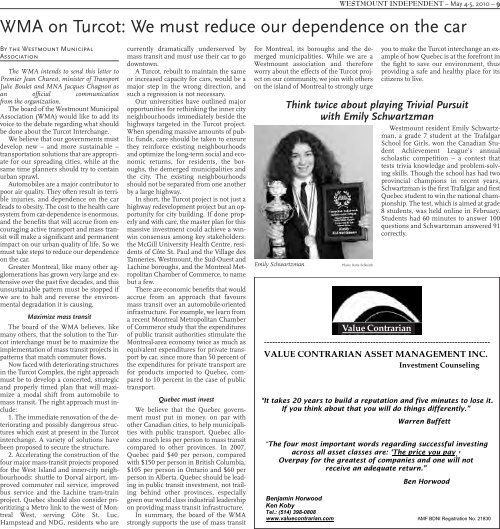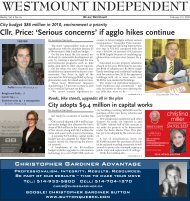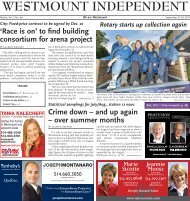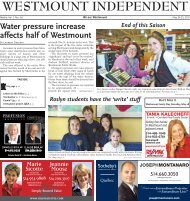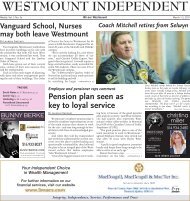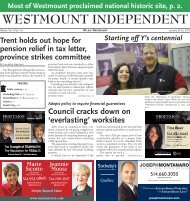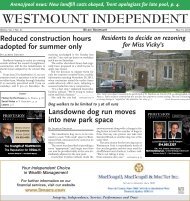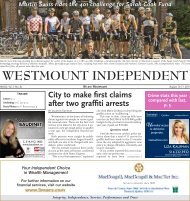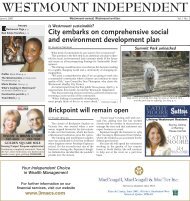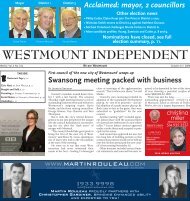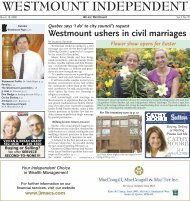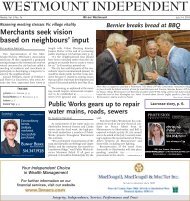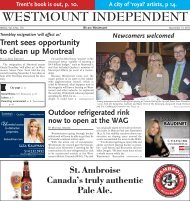8 – WESTMOUNT INDEPENDENT – May 4-5, 2010Letters to the EditorDismount cyclists ordivert pathIt is unfortunate that the bicycle pathbisecting <strong>Westmount</strong> Park has morphedinto a high-speed lane for cyclists in ahurry. Moreover it has attracted hoodlumson wheels who feel free to spread throughoutthe park.The other day four young men in identicalsmall-wheeled, high-handle bikes(possibly a gang?) cycled at a high speedthrough the lawns and most shockingly,through the playground full <strong>of</strong> little children.There were no security <strong>of</strong>ficers onhand.Had they been driving cars they wouldhave had their driver’s licences suspended.Pending stringent measures to correct thisproblem, I regret to have to say (as a recreationalcyclist) that diverting the path awayfrom the park, or forcing cyclists to dismount,might be the only solution.Maya Khankhoje, Kensington Ave.Re-use, re-surface,re-consultOn the surface, the arena expansionseems exciting. There is no doubt thatcommunity infrastructure that expandsrecreational possibilities, while increasinggreen space, is a great concept.However, I dislike the threat “If wedon’t spend the grant, we’ll lose it.” UsingWeeklyPresstime: Monday at 10:30 amPublisher & editor-in-chief: David Priceeditor: Kristin McNeillChief reporter: Laureen SweeneyPro<strong>of</strong>reader: Stella MindorffLetters & Comments:We welcome your letters, but reserve the rightto choose and edit them. Please limit to 300words. Please check your letter carefully.We may be unable to make subsequentlysubmitted changes. If you do makeamendments, please “redline” them instead <strong>of</strong>resending the whole letter. Email any letteror comments toindie@westmountindependent.com.Every letter <strong>of</strong> support helps us with advertisers!WESTMOUNTINDEPENDENTWe are <strong>Westmount</strong>.How Can We Help You?Stories and lettersKristin McNeill: 514.223.3578indie@westmountindependent.comAdvertising & SalesArleen Candiotti: 514.223.3567advertising@westmountindependent.comAccountingBeth Hudson: 514.223.6138<strong>of</strong>fice@westmountindependent.comAudited by13,789 copiesOwned and published by:Sherbrooke-Valois Inc., 310 Victoria Ave., #105, <strong>Westmount</strong>, QC H3Z 2M9Fax: 514.935.9241people’s panic reflex is not a trustworthymethod to engage support. Method isparamount in sustainability and coercingthe citizens into an expensive course <strong>of</strong> actionmakes it suspicious.A complete demolition and rebuildmay be the only rational way to deal withthe poorly conceived existing structure.However, sustainable practices tend to useexisting assets and integrate them. Growingup in <strong>Westmount</strong>, I never suffered dueto those “inadequate” premises!I don’t agree with the necessity <strong>of</strong> tw<strong>of</strong>ull-sized hockey rinks. One indoor rink isenough, accompanied by two outdoorones. Why not use the park fields for skating– in seasonal rotation? Surely the energysavings are incomparable, and itmight be a bit more pleasant to skate inthe open air rather than in an artificially litunderground cavern.It seems that much <strong>of</strong> this project isdriven by a need for excessive luxury. Thisis not just a money issue, but more importantlyit is a time and focus issue.While we spend our energy on this project,other important functions may sufferneglect.The <strong>real</strong>ity <strong>of</strong> the grant money cannotbe ignored, and the design has merit, butis it <strong>real</strong>ly the best way for the municipalityto invest public funds? If the buildinghopes to pass as remotely sustainable,then <strong>real</strong> public consultation needs to happen;however, it seems that they are fishingfor public approval at the eleventhhour when public input will be anecdotal.This smells more <strong>of</strong> a political manoeuvrethan an honest consultation.Marcus Macdonald, formerly aStayner Ave. resident, now lives inWhite Rock, BC.Bury the parkingnot the rinkI feel the current design is an excellentnext step in the arena design process – animprovement over the first set <strong>of</strong> proposalsbut not the final version.What this design does is to take as“ground level” the west side <strong>of</strong> the lot andnot the east, as is currently the case. Agreat improvement – it lowers the overallbuilding height and allows for some interestinggreen ro<strong>of</strong> alternatives.Unfortunately, as drawn, it buries therinks but not the parking. I would preferthe other way around. I would like to see atleast one <strong>of</strong> the rinks at, or close to,ground level (west side), replace the parkingwith a rink and put the parking underneathit.I would like to see the west facade <strong>of</strong>this rink with as much glass as possible allowingfor a flood <strong>of</strong> natural light and anapproximation <strong>of</strong> the outdoor rink experience.Yes, glass creates heat gain but a littlecreative design can make use <strong>of</strong> theheat generated before it gets into the arenaspace.As for an indoor pool, I would like tosee council make a firm commitment to<strong>of</strong>fer alternatives, such as full and free accessfor residents to all the facilities at theYMCA. As your population stats showed,the demand for full recreational facilitiesfor “seniors” 55 and over is going to increase.So, while I support the arena project inprinciple, we would like to see an improveddesign.Claire Salzberg, Claremont Ave.Attract people to VicVillage with a square, notrestosI was at the April 26 council meetingheld to discuss the proposed changes tothe by-law governing restaurants in theVictoria Village area. Many <strong>of</strong> the merchantsthere expressed the hope thatadding restaurants would increase trafficin their stores. I would like to suggest thattraffic could be increased without convertingthe area into a restaurant row.Two main ideas would be to improvesidewalk cleanliness à la Destination CentreVille and create a small square at the top<strong>of</strong> Prince Albert where there are currentlyfour inadequate benches. The squarewould extend that seating area “south” onPrince Albert to the small alley behind LaFoumagerie.I’ve made some paced-<strong>of</strong>f measurementsand the resulting square would besimilar in size to the one currently atGreene and de Maisonneuve. The “southern”side <strong>of</strong> the square could be a goodspot for Bixi bikes.The whole area should be looked at in anew green neighbourhood context, morefoot-friendly, more bike-friendly, less carfriendly.The novelty <strong>of</strong> such a spot wouldbe the “hook” that merchants might findincreases their business.Richard Aylett, Claremont Ave.Golden arena?Has a “LEED scorecard” <strong>of</strong> what LEED[Leadership in Energy and EnvironmentalDesign] credits are foreseen by the arena’sdesign pr<strong>of</strong>essionals been published, so asto know whether they are overlookingcredits that might take the project intoGold territory?Is <strong>Westmount</strong>’s desire to advance activetransport supported by the increase in 40parking places cut into the slope? Shouldn’tthat idea be shelved and, in its stead,reserve all well-positioned parking placesfor hockey car pooling – that is, for vehiclesthat bring two or more players to thegame?The number <strong>of</strong> needed parking spotsmight be reduced by up to 75 percent.More to the point, the greater part <strong>of</strong> <strong>Westmount</strong>lives within a 15-minute walk tothe arena. Could we not expect most athletesto walk to their game? The hockeybag, though bulky, is not heavy since whenwearing all the equipment the player isunimpeded in traversing the rink at greatspeed.Cost estimates come in differentclasses. Some, because <strong>of</strong> incomplete information,carry large margins <strong>of</strong> error.The estimate for the arena project is <strong>of</strong>what class? What margin <strong>of</strong> error does itcarry? Have boreholes * been analyzed?For such a major underground project,these analyses are essential for costing andfeasibility.Has the idea <strong>of</strong> <strong>year</strong>-round hockey icebeen approved by <strong>Westmount</strong> after debate?As part <strong>of</strong> the needs analysis, haspolling been done to ascertain whetherthere is a larger demandfor an indoor pool or a sec-continued on p. 7
WESTMOUNT INDEPENDENT – May 4-5, 2010 – 9WMA on Turcot: We must reduce our dependence on the carBy the <strong>Westmount</strong> MunicipalAssociationThe WMA intends to send this letter toPremier Jean Charest, minister <strong>of</strong> TransportJulie Boulet and MNA Jacques Chagnon asan <strong>of</strong>ficial communicationfrom the organization.The board <strong>of</strong> the <strong>Westmount</strong> MunicipalAssociation (WMA) would like to add itsvoice to the debate regarding what shouldbe done about the Turcot Interchange.We believe that our governments mustdevelop new – and more sustainable –transportation solutions that are appropriatefor our spreading cities, while at thesame time planners should try to containurban sprawl.Automobiles are a major contributor topoor air quality. They <strong>of</strong>ten result in terribleinjuries, and dependence on the carleads to obesity. The cost to the health caresystem from car-dependence is enormous,and the benefits that will accrue from encouragingactive transport and mass transitwill make a significant and permanentimpact on our urban quality <strong>of</strong> life. So wemust take steps to reduce our dependenceon the car.Greater Mont<strong>real</strong>, like many other agglomerationshas grown very large and extensiveover the past five decades, and thisunsustainable pattern must be stopped ifwe are to halt and reverse the environmentaldegradation it is causing.Maximize mass transitThe board <strong>of</strong> the WMA believes, likemany others, that the solution to the Turcotinterchange must be to maximize theimplementation <strong>of</strong> mass transit projects inpatterns that match commuter flows.Now faced with deteriorating structuresin the Turcot Complex, the right approachmust be to develop a concerted, strategicand properly timed plan that will maximizea modal shift from automobile tomass transit. The right approach must include:1. The immediate renovation <strong>of</strong> the deterioratingand possibly dangerous structureswhich exist at present in the Turcotinterchange. A variety <strong>of</strong> solutions havebeen proposed to secure the structure.2. Accelerating the construction <strong>of</strong> thefour major mass-transit projects proposedfor the West Island and inner-city neighbourhoods:shuttle to Dorval airport, improvedcommuter rail service, improvedbus service and the Lachine tram-trainproject. Quebec should also consider prioritizinga Metro link to the west <strong>of</strong> Mont<strong>real</strong>West, serving Côte St. Luc,Hampstead and NDG, residents who arecurrently dramatically underserved bymass transit and must use their car to godowntown.A Turcot, rebuilt to maintain the sameor increased capacity for cars, would be amajor step in the wrong direction, andsuch a regression is not necessary.Our universities have outlined majoropportunities for rethinking the inner cityneighbourhoods immediately beside thehighways targeted in the Turcot project.When spending massive amounts <strong>of</strong> publicfunds, care should be taken to ensurethey reinforce existing neighbourhoodsand optimize the long-term social and economicreturns, for residents, the boroughs,the demerged municipalities andthe city. The existing neighbourhoodsshould not be separated from one anotherby a large highway.In short, the Turcot project is not just ahighway redevelopment project but an opportunityfor city building. If done properlyand with care, the master plan for thismassive investment could achieve a winwinconsensus among key stakeholders:the McGill University Health Centre, residents<strong>of</strong> Côte St. Paul and the Village desTanneries, <strong>Westmount</strong>, the Sud-Ouest andLachine boroughs, and the Mont<strong>real</strong> MetropolitanChamber <strong>of</strong> Commerce, to namebut a few.There are economic benefits that wouldaccrue from an approach that favoursmass transit over an automobile-orientedinfrastructure. For example, we learn froma recent Mont<strong>real</strong> Metropolitan Chamber<strong>of</strong> Commerce study that the expenditures<strong>of</strong> public transit authorities stimulate theMont<strong>real</strong>-area economy twice as much asequivalent expenditures for private transportby car, since more than 50 percent <strong>of</strong>the expenditures for private transport arefor products imported to Quebec, comparedto 10 percent in the case <strong>of</strong> publictransport.Quebec must investWe believe that the Quebec governmentmust put in money, on par withother Canadian cities, to help municipalitieswith public transport. Quebec allocatesmuch less per person to mass transitcompared to other provinces. In 2007,Quebec paid $40 per person, comparedwith $150 per person in British Columbia,$105 per person in Ontario and $60 perperson in Alberta. Quebec should be leadingin public transit investment, not trailingbehind other provinces, especiallygiven our world class industrial leadershipon providing mass transit infrastructure.In summary, the board <strong>of</strong> the WMAstrongly supports the use <strong>of</strong> mass transitfor Mont<strong>real</strong>, its boroughs and the demergedmunicipalities. While we are a<strong>Westmount</strong> association and thereforeworry about the effects <strong>of</strong> the Turcot projecton our community, we join with otherson the island <strong>of</strong> Mont<strong>real</strong> to strongly urgeEmily Schwartzmanyou to make the Turcot interchange an example<strong>of</strong> how Quebec is at the forefront inthe fight to save our environment, thusproviding a safe and healthy place for itscitizens to live.Think twice about playing Trivial Pursuitwith Emily SchwartzmanPhoto: Katie FellerathValue Contrarian<strong>Westmount</strong> resident Emily Schwartzman,a grade 7 student at the TrafalgarSchool for Girls, won the Canadian StudentAchievement League’s annualscholastic competition – a contest thattests trivia knowledge and problem-solvingskills. Though the school has had twoprovincial champions in recent <strong>year</strong>s,Schwartzman is the first Trafalgar and firstQuebec student to win the national championship.The test, which is aimed at grade8 students, was held online in February.Students had 60 minutes to answer 100questions and Schwartzman answered 91correctly.


